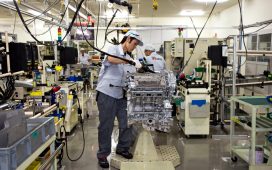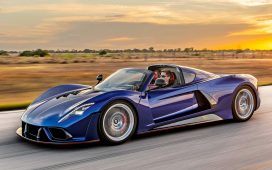The world is rallying behind the EV offensive as more countries and regions vow to phase out combustion vehicles. Kia is now among the most appreciated brands at the forefront of this offensive, but it wasn’t always like that. Here’s how Kia advanced from a small bicycle manufacturer to the posh EV maker of today.
Even in its modern history, Kia wasn’t seen as anything revolutionary, similar to its sister-brand Hyundai. They have been building honest cars at affordable prices for the past two decades without standing out for anything in particular. But as the EV revolution started, Kia was at the forefront of this offensive, thanks to the excellent EV-dedicated platform known as E-GMP. But the beginnings were humble, and it’s worth reminding everyone how far the Korean brand has come.
Since we’re mainly talking about Kia’s electric cars, we can jokingly say that the Korean brand produced its first zero-emission vehicle in 1952. It was a two-wheel vehicle, the first bicycle ever made in Korea. Its first car came much later, in 1974, as a licensed copy of Mazda Familia, a small family car sold in Korea as the Kia Brisa. The military dictatorship in Korea put a stop to Kia’s automotive efforts. Things got back on track in 1986, and Kia partnered with Ford and started producing several Mazda-derived models.
A young brand with a history in EVs
As you see, there weren’t many opportunities for the Korean brand to explore electric vehicles. By the time it produced its first car, the 1970s oil crisis was over, and nobody thought of electric vehicles. However, Kia made its first fully electric car in 1988: the Besta EV. The Besta was the passenger van version of the second-generation Bongo, a small cabover pickup truck. Although not sold commercially, the Besta EV was used for live broadcasting during the 1988 Seoul Olympics.
Surprisingly, another crisis provided the most significant boost to Kia. The Asian financial crisis forced the Korean brand to declare bankruptcy in 1997, and Hyundai outbid Ford to acquire a controlling stake in the company. That was the start of an impressive journey for Kia, which led to where it is today. And since Hyundai was among the pioneers of hydrogen fuel-cell vehicles, Kia followed that path too.
The experimental Kia Sportage Fuel Cell EV was launched in 2004, followed by its first commercially available FCEV model, the Mojave, also known as Borrego in the US. It was announced in 2008 during the Los Angeles Auto Show and was produced in limited numbers between 2010 and 2012. Kia later quit the FCEV game and launched its first series production electric vehicle in 2014: the Soul EV.
Kia Soul EV: the precursor of the modern Kia EVs
The Soul was actually designed by Kia’s design center in California, so it has a solid North American vibe. The Soul EV was based on the second generation of the model and was pretty advanced for the time. Remember, the Nissan Leaf was launched only three years earlier, and the first Tesla Model S was delivered in 2012.
The Kia Soul shared the design and platform with its ICE brother, which explains why the performance was not very good. A square box cannot be very efficient, and the 120-mile (190 km) range was nothing to impress, considering the Tesla Model S already offered twice that. But the Soul EV was much more affordable, although this meant limiting the Li-ion battery capacity to only 27 kWh.
The Kia Soul EV got a massive battery capacity boost with the second generation launched in 2019. The Soul EV II had a 64 kWh battery, doubling the range compared to the previous generation. Unfortunately, the redesigned model was delayed in the US due to the pandemic and later canceled altogether. The main reason was that Kia already had a successful electric vehicle in the US market: the Niro EV.
Kia Niro EV: stealing the limelight
The Kia Niro launched in 2016 with gas-powered, hybrid, plug-in hybrid, and fully-electric powertrains. The Niro EV was the latest to enter the market in 2018, sharing the powertrain and battery configuration with the Hyundai Kona EV. The most capable variant featured a 64 kWh battery and a 150 kW (201 horsepower) electric motor in a front-wheel drive configuration. The official EPA range was 239 miles (385 km), a respectable figure at the time.
Hyundai launched the second-generation Niro in 2021, with the Niro EV debuting in April 2022. The updated model shares the platform with the second-generation Kona and, like the previous model, is also available as an ICE, hybrid, plug-in hybrid, and electric version. Technically, not much has changed compared to the previous generation, with a similar 64-kWh battery and 201-horsepower motor. Still, the range is now 253 miles (407 km) thanks to improved efficiency.
The Kia Niro EV starts at $39,600, which should’ve been a competitive price. Unfortunately, it doesn’t qualify for the IRA tax credit, which means it can’t compete with the bestseller Tesla Model Y. Outperformed in power and range and more expensive, the Kia Niro EV is also overshadowed by its more modern sister, the Kia EV6. The latter debuts Hyundai-Kia’s most modern automotive platform, the E-GMP.
E-GMP platform: the backbone of Kia’s current EV lineup
E-GMP stands for Electric Global Modular Platform and was designed from the ground up to underpin all future electric vehicles of Hyundai, Kia, and Genesis. Hyundai first acknowledged the development of the new platform in 2017, at a time when very few carmakers have done so. If you’re curious, Volkswagen developed its MEB platform around the same time. The advantage of having an EV-dedicated platform, as opposed to an adapted ICE architecture, is a more efficient construction and improved space offering.
Unlike the Volkswagen platform, which was designed as a stop-gap measure (but never replaced), Hyundai-Kia shoots for the stars with the E-GMP. This is an 800-volt architecture, something that only Porsche developed at the time. The advantages of having double the voltage are multiple. The current drawn from the battery is halved, reducing the copper wire diameter and saving weight in the process.
The higher voltage also allows higher performance and shorter charging times, with EVs built on the platform charging from 10% to 80% in about 18 minutes. That’s about the fastest on the market when connected to a 350-kW charger. The E-GMP also uses more efficient hairpin-winding motors, which Tesla only recently started offering. Another advantage of the E-GMP platform is the support for bi-directional charging.
Kia EV6: the electric vehicle that jumpstarted Kia’s electric revolution
The EV6 was not only the most advanced electric car in Kia’s lineup but also the first to use the new nomenclature, which will range from EV1 to EV9. The design is hard to fit into one category, with characteristics at the crossroads between hatchbacks and crossovers. This has the advantage of being unique, although the cabin space and the trunk capacity suffer. Kia compensates for this with a comprehensive feature list and an impressive build quality that puts rivals to shame.
The price in the US starts at $42,600, which is $3,000 higher than the Niro EV. However, it has many advantages, which makes the difference well worth it. Among them are the better range, the fact that it can also be ordered as an all-wheel drive model, and the performance boost afforded by the E-GMP platform. If you’re a fan of sporty driving, the Kia EV6 GT puts 576 horsepower under your foot, enough to accelerate from zero to 60 mph in 3.4 seconds. It will set you back $61,600, though, which is quite steep.
The most affordable variant, the Kia EV6 Light, has a 58-kWh battery pack and a 167-hp motor, allowing it to travel 232 miles (373 km) on a charge. The Wind trim ups the battery to 77 kWh and the motor to 225 horsepower, with a 310-mile (499 km) range. Adding a front motor raises the power to 320 horsepower, but the range takes a hit at 282 miles (454 km). Finally, the EV6 GT sacrifices a lot to feed the 576 horses, dropping the range to 206 miles (332 km).
Kia EV9: the three-row SUV that aims to revolutionize the electric SUV segment
The EV9 debuted in April at the 2023 New York Auto Show and made a strong impression. The three-row SUV is the second Kia EV built on the E-GMP platform and probably the most expensive, with a starting price of $54,900. The pricing of the higher trims is still unknown, even though the sales will start this quarter. It’s important to know that the EV9 will become Kia’s first made-in-USA electric vehicle from next year.
Although the EV9’s range and power figures are not that impressive, Kia’s electric SUV has a lot to speak for itself. The RWD variant will reach about 300 miles of range with the larger 100-kWh battery. It will not be very fast, though, as its electric motor has only 201 horsepower. The maximum power of 379 horsepower is available in the AWD configuration, although the range will be penalized in this case. We still don’t know by how much, as Kia has not yet revealed all the technical details.
The most exciting detail of the Kia EV9 is its modular cabin, with the swiveling captain’s chairs on the second row as the electric SUV’s signature feature. It is slightly longer than the Telluride, offering a spacious cabin and many storage compartments. The trunk has up to 20.2 cubic feet (572 liters) of cargo space with all three rows raised. When both rows of rear seats are folded, the volume increases to 81.9 cubic feet (2,320 liters).
Kia adopts Tesla’s NACS charge plug in the US
Kia, alongside its parent company Hyundai, announced adopting the NACS charging plug on its electric vehicles starting in Q4 2024. All existing Kia EVs will gain access to the Tesla Supercharger network in 2025. The move has been highly anticipated, although the Korean carmaker had few incentives to adopt Tesla’s open-sourced charging standard. Its 800-volt electrical architecture makes the Tesla Supercharger a less-than-optimal charging solution for Kia EVs.
The reason is that all Supercharger stations in the US are now populated with 400-volt chargers, and experience shows that they don’t offer an acceptable charging time for an 800-volt EV. This mainly happens because their internal DC-DC converter is limited to 50 kW. This is a serious shortcoming, as the DC-DC converter is essential to converting the 400 volts delivered by the Supercharger station to the 800 volts needed by the car’s battery.
To improve this situation, Hyundai must change the DC-DC converter (or, rather, the inverter it uses for this purpose). Kia’s future EVs will likely offer at least 100 kW in this department. Another way to alleviate this problem is by using 800-volt Supercharger stations. Tesla is already deploying Supercharger V4 stations in Europe, and the first US station will come online soon. Supercharger V4 is said to charge at 1,000 volts, vastly improving the charging experience for Kia and other 800-volt EV owners.
Kia’s future electric vehicles: 14 new models by 2030
Last year, Kia confirmed plans to launch 14 EV models by 2030, with total sales of 1.2 million cars per year. While the number of models seems overblown, the planned output seems rather disappointing. Many carmakers aim to simplify their lineup, so 14 models are overkill. Also, Tesla is on track to produce 1.8 million EVs this year, and planning for only 1.2 million in seven years doesn’t seem ambitious enough.
The plans may have changed already, and we’re all anxiously awaiting the Kia EV Day, scheduled for October 12, to learn more. Until then, we only have a teaser photo showing five car silhouettes. Based on their DRL signatures, we can identify the EV6, EV9, and the upcoming EV5, which has just been unveiled in China. The scarce information points to an electric Sportage equivalent, which was long in the making.
The smaller crossover could be the rumored EV4 subcompact SUV that will be unveiled during the October 12 EV Day. The model will likely come in a single-motor configuration, akin to a Niro EV replacement that will slot beneath the EV5 in the future. Finally, the fifth silhouette looks like a sedan (could it be EV7?), which means Kia might be preparing its own take on the Hyundai Ioniq 6. Considering the two brands launch their models in pairs, a Kia electric sedan seems long overdue.


















